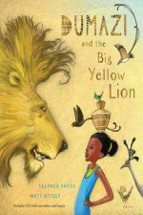Dumazi and the big yellow lion by Valanga Khoza

Illus. by Matt Ottley. Scholastic 2019. ISBN: 9781742994116.
(Age: 4+) Highly recommended. Themes: Fable, Lions, Africa, Folk
tale. When Dumazi walks from her village to the waterhole, a
calabash on her head she hears a lion bemoaning its fate in the
bushes. He has been caught by a hunter's rope trap and cannot get
out. He promises Dumazi that if she releases him he will not eat
her. She releases him only to find that he intends to break his
promise. She takes him to see some other animals to see what they
say about the lion eating her, but each that she sees, has their own
reason for telling the lion to go ahead and eat her. The giraffe
recalls that Dumazi is a human and humans are responsible for
setting things on fire and building fences which have restricted the
animal's jungle home. She asks the elephant, and the elephant shows
her his half sawn off tusk, taken by poachers, so tells the lion to
go ahead and eat her. But the monkey derides the lion, saying he
will tell all the animals that the lion was caught in a rope trap
and laugh at him. He then cleverly gets the lion to show hm the rope
trap and how he was caught, so entangling himself again. The clever
monkey slips back into the jungle warning the lion not to make
promises he cannot keep, and deploring his behaviour towards Dumazi
who saved his life.
This wonderful tale full of the sights and sounds of Africa, will be
adored by all readers, intrigued with the brave Dumazi wanting to
release the lion but cautious lest it try to eat her. Her solution
of finding what other animals think reveals the problems humans have
brought to this land, and the cleverness of the monkey in trapping
the lion over again will bring gales of laughter from the audience.
Ottley's wonderful illustrations depict a broad sweep of Africa,
with smaller animals and insects at Dumazi's feet. The drawing of
the lion completely helpless in the path of the stampeding buffalo
will evoke sympathy in the reader, despite his duplicitous behaviour
towards the Zulu girl. Ottley creates images from a different
perspective, uses shadows to create interest and drama, and enfolds
much of the book in a glorious sun shiney golden hue. I loved every
page.
Fran Knight